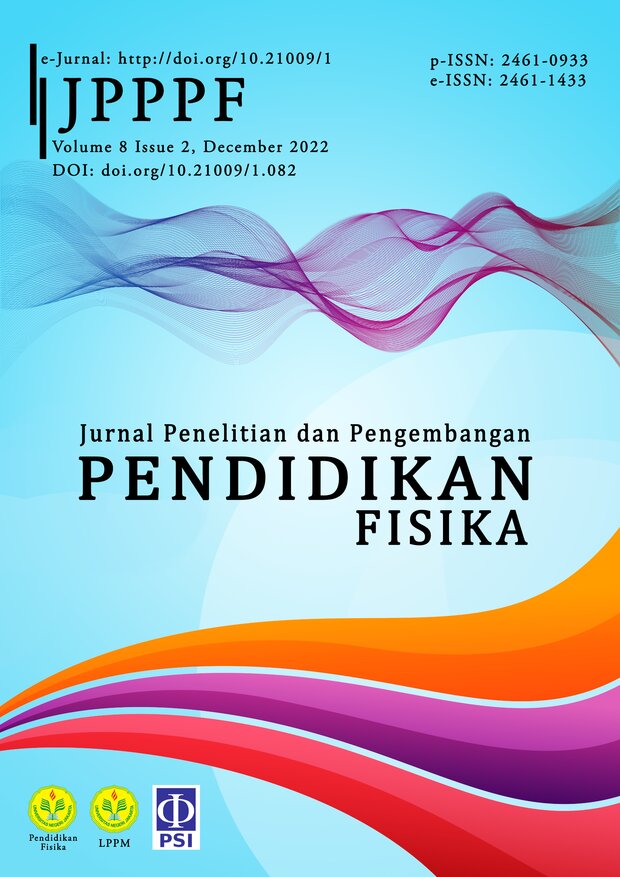Developing PHYCOM (Physics Comics) on Newton’s Law Material for 10th Grade High School Students
DOI:
https://doi.org/10.21009/1.08201Keywords:
physics, Newton’s law, PHYCOMAbstract
This research aims to develop high school physics teaching materials in the form of comics. This research method is a research and development (R&D) method. The steps in this method are Analysis-Design-Development-Implementation-Evaluation (ADDIE). A validation test was carried out using a questionnaire to obtain valid Physics Comics (PHYCOM) teaching materials. This feasibility test was carried out by three validators consisting of 1 high school physics teacher, two lecturers, and six 10th-grade high school students. Comics are said to be valid and feasible to use because they meet the validity percentage at a value of 61% - 100% (valid criteria and very valid). Based on the results of the feasibility test of the three validators, it was found that PHYCOM's teaching materials were very valid and feasible to use, with a percentage of 87.50%. The validation results from six students showed that PHYCOM was a very valid teaching material with a validity percentage of 91.18%. The results of this validation indicate that PHYCOM is valid and suitable to be used as teaching materials for 10th high school students. The advantage of PHYCOM teaching materials is that they are communicative and contain illustrative images so that they are easy to visualize. In addition, PHYCOM teaching materials can be used by students as independent study materials.
References
Akrom, Muhammad. “Analisis Ketampanan Nabi Yusuf Dalam Perspektif Semiotika Al-Qur’an.” Arabiyat : Jurnal Pendidikan Bahasa Arab Dan Kebahasaaraban 1, no. 2 (31 Desember 2014): 223–36. https://doi.org/10.15408/a.v1i2.1141.
Ali, Faila Sufatun Nisak. “Penafsiran QS. Al-Fatihah K.H Mishbah Mustafa : Studi Intertekstualitas Dalam Kitab Al-Iklil Fi Ma’ani At-Tanzil.” Al Iman: Jurnal Keislaman Dan Kemasyarakatan 3, no. 2 (9 September 2019): 150–79.
Ali Imron, S. S. “Kisah Nabi Yusuf a.s. Dalam Al-Qur’an (Kajian Semiotika).” Masters, UIN Sunan Kalijaga, 2010. http://digilib.uin-suka.ac.id/6968/.
Al-Makin. Keragaman dan perbedaan: budaya dan agama dalam lintas sejarah manusia, 2016.
Dianto, Icol. “Paradigma Perubahan Sosial Perspektif Change Agent Dalam Al-Quran (Analisis Tematik Kisah Nabi Yusuf As).” Jurnal Sosiologi Reflektif 14, no. 1 (8 November 2019): 59–80. https://doi.org/10.14421/jsr.v14i1.1476.
El Shirazy, Habiburrahman. “Berdakwah Dengan Puisi (Kajian Intertekstual Puisi-Puisi Religius Taufiq Ismail),” t.t.
Fina, Lien Iffah Naf’atu. “Pre Canonical Reading of the Qur’an: Studi atas Metode Angelika Neuwirth dalam Analisis Teks Alquran Berbasis Surat dan Intertekstualitas.” Yogyakarta: UIN Sunan Kalijaga, 2011.
Hamersma, Harry. Tokoh-Tokoh Filsafat Barat Modern. Jakarta: Gramedia Verl., 1992.
Hanif, Muhammad. “Kisah Nabi Yusuf Dalam Al-Qur’an; Kajian Stilistika Alquran Surah Yusuf.” AL-AF’IDAH: Jurnal Pendidikan Bahasa Arab Dan Pengajarannya 2, no. 2 (1 September 2018): 1–27.
Harun, Amrullah. “Kisah Yusuf/Joseph Dalam Al-Qur’an Dan Alkitab” 7, no. 1 (13 Agustus 2019). http://journal.uin-alauddin.ac.id/index.php/tafsere/article/view/9939.
Khikmatiar, Azkiya. “Kisah Nabi Nuh Dalam Al-Qur’an (Pendekatan Intertekstual Julia Kristeva).” At-Tibyan: Jurnal Ilmu Alqur’an Dan Tafsir 4, no. 2 (16 Desember 2019): 209–26. https://doi.org/10.32505/tibyan.v4i2.1144.
Kristeva, Julia. Desire in Language: A Semiotic Approach to Literature and Art. S.l.: Columbia Univ. Press, 2006.
———. Le Texte Du Roman: Approche Sémiologique d’une Discursive Transformationelle. The Hague, Paris: Mouton, 1970.
———. Polylogue. Paris: Seuil, 1977.
———. Powers of horror: an essay of abjection. New York ; Chichester: Columbia University Press, 1984.
———. Sēmeiotikē: recherches pour une sémanalyse, 2017.
———. Strangers to Ourselves. New York: Harvester Wheatsheaf, 1996.
Kristeva, Julia, dan Leon Samuel Roudiez. Black Sun: Depression and Melancholia. New York: Oxford : Columbia University Press, 2006.
Kristeva, Julia, Leon Samuel Roudiez, dan Margaret Waller. Revolution in Poetic Language. New York: Columbia University Press, 2006.
MA, Dr Munzir Hitami. Pengantar Studi Al-Qur’an: Teori dan Pendekatan. Lkis Pelangi Aksara, t.t.
Mardalis. Metode penelitian: suatu pendekatan proposal. Jakarta: Bumi Aksara, 1995.
Mukti, Beta Pujangga. “Strategi Ketahanan Pangan Nabi Yusuf: Studi Analisis tentang Sistem Ketahanan Pangan Nabi Yusuf dalam Al-Quran Surat Yusuf Ayat: 46-49.” Tarjih: Jurnal Tarjih dan Pengembangan Pemikiran Islam 16, no. 1 (22 Juni 2019): 35–47.
Neuwirth, Angelika, Michael Marx, dan Nicolai Sinai. Qur’an in Context: Historical and Literary Investigations into the Qur’anic Milieu. Leiden: Brill, 2009.
Nurdin, Ali. “Etika Pergaulan Remaja Dalam Kisah Nabi Yusus AS (Telaah Tafsir Tarbawi dalam Surat Yusuf Ayat 23-24).” Andragogi: Jurnal Pendidikan Islam dan Manajemen Pendidikan Islam 1, no. 3 (20 Desember 2019): 490–510. https://doi.org/10.36671/andragogi.v1i3.69.
Pratama, Oka Putra. “Kesantunan Berbahasa:Prosa Bografi Kisah Nabi Yusuf Dalam Al-Qur’an,” Oktober 2017. http://repository.uinjkt.ac.id/dspace/handle/123456789/41634.
———. “Tindak Tutur Santun Dalam Kisah Nabi Yusuf.” Arabiyat : Jurnal Pendidikan Bahasa Arab dan Kebahasaaraban 4, no. 2 (28 Desember 2017): 227–54. https://doi.org/10.15408/a.v4i2.6352.
Rahmah, Mariyatul Norhidayati. “Model Komunikasi Interpersonal Dalam Kisah Nabi Yusuf As.” Al-Hiwar : Jurnal Ilmu Dan Teknik Dakwah 4, no. 6 (21 April 2017). https://doi.org/10.18592/al-hiwar.v4i6.1212.
Robikah, Siti. “Tafsir Surah Yusuf Dalam Alquran Dengan Pendekatan Sastra Mustansir Mir.” Al-Bayan: Jurnal Studi Ilmu Al- Qur’an dan Tafsir 4, no. 1 (30 Juni 2019). https://doi.org/10.15575/al-bayan.v4i1.4208.
Rusmana, Dadan. Filsafat Semiotika, Paradigma, Teori, dan Metode Interpretasi Tanda dari Semiotika Struktural Hingga Dekontruksi Praktis. Bandung: Pustaka Setia, 2014.
Sodiqin, Ali, dan Abdul Qodir Shaleh. Antropologi al-quran: model dialektika wahyu & budaya. Yogyakarta: Ar-ruzz Media, 2008.
Stott, John R. W, dan Paul Hidayat. Memahami isi Alkitab, 1984.
Sulaikho’, Siti. “Komparansi Kisah Yusuf Dan Zulaikha Antara Perjanjian Lama Dan Al-Qur’an.” Al-Lahjah 2, no. 2 (2018): 72–86.
Taufiq, Wildan. Semiotika Untuk Kajian Sastra dan AlQuran. Bandung: Yrama Widya, 2016.
Yusuff, Mohd Sholeh bin Sheh. “Bacaan Intertekstual terhadap Sumber Al-Isra’iliyyat dalam Tafsir Nur al-Ihsan.” INSANCITA 3, no. 1 (2 Maret 2018). https://doi.org/10.2121/incita-jisisea.v3i1.965.
Zulaikhoh, Siti. “Kisah Nabi Yusuf As. (Ibrah Dan Implementasi Konseptual Dalam Pendidikan).” Other, IAIN Salatiga, 2015. http://e-repository.perpus.iainsalatiga.ac.id/.











